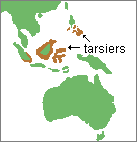The Anthropology Tutorials website will be taken offline on January 9, 2026.
Due to federal accessibility requirements taking effect in 2026, we will be removing this site. If you use materials from this site in your courses or research, please seek alternative resources.
Lorises and Tarsiers
While the
lemurs only live on the island of Madagascar, there are at least 11 species
of Strepeirhini (or prosimians) living in mainland tropical forests elsewhere in the Old World.
They are the lorises
 of India and Southeast Asia as well as the pottos
of India and Southeast Asia as well as the pottos
 ,
angwantibos
,
angwantibos
 , and
galagos
, and
galagos
 of Africa. All of them are
arboreal
and omnivorous.
However, their hunting is largely limited to easy prey such as insects, eggs,
and baby birds. The fact that they are strictly nocturnal
has allowed them to largely avoid direct competition with the monkeys and
apes, which are all diurnal
in the Old World.
of Africa. All of them are
arboreal
and omnivorous.
However, their hunting is largely limited to easy prey such as insects, eggs,
and baby birds. The fact that they are strictly nocturnal
has allowed them to largely avoid direct competition with the monkeys and
apes, which are all diurnal
in the Old World.
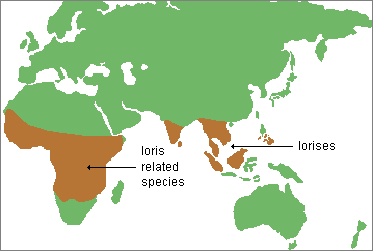 |
| Natural range of the loris
superfamily |
The lorises
and related African species
are members of the infraorder
Lorisiformes
 . The lemurs
are in the infraorder Lemuriformes
. The lemurs
are in the infraorder Lemuriformes
 .
.
|
suborder: |
Strepsirrhini (prosimians) |
|
infraorder: |
Lemuriformes |
Lorisiformes |
|
family: |
Lemuridae |
Lepilemuridae |
Cheirogaleidae |
Indriidae |
Daubentoniidae |
Loridae |
Galagonidae |
|
species: |
ring-tailed and ruffed lemurs |
sportive lemurs |
dwarf and mouse lemurs |
indris
avahis
sifakas |
aye-ayes |
lorises
pottos
angwantibos |
galagos |
The families of the
Lorisiformes
can be distinguished based largely on locomotor patterns.
The Asian lorises and their close African relatives, the pottos and angwantibos, are
slow, deliberate climbers and creepers on forest branches. They are the size of
domesticated cats. In contrast,
the diminutive 8 inches (20 cm.) long African galagos, or bush babies, are agile hoppers--a
single jump can be 6-7
feet (1.8-2.1 meters). Both types of
locomotion have advantages for survival. The slow cautious moving lorises and pottos are hard
to spot by predators, and the fast moving galagos are hard to catch.
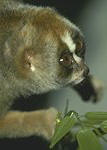 |
|
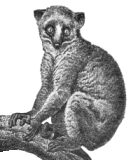 |
|
 |
|
Senegalese galago |
|
Slow loris |
Potto |
|
Lorises have one
other form of defense that makes up for their slow movements. They have unpleasant
tasting somewhat poisonous saliva that they lick onto their fur. Mother lorises
also lick the fur of their babies which helps to protect them from potential
predators.
The galagos are the most numerous African primate other
than humans, however, few people see them because they live in dense forests
and are only active at night.
Tarsiers
| |
|
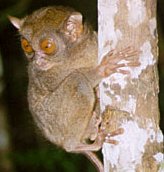
|
| Tarsier |
The large rat
size tarsier
 of Southeast Asia is another unusual
primate. Their classification is problematical because
they
have what appears to be a blend of prosimian and monkey traits,
but they are genetically somewhat different from both
groups of primates. Some researchers consider them to be a third suborder of the
Strepsirrhini because of
their small size and galago-like behavior. Others emphasize the fact that they lack the
wet noses characteristic of lemurs and lorises. Subsequently, they
place them in the suborder Haplorrhini along with monkeys, apes, and
humans.
The second of these two alternatives is used in this tutorial with the
understanding that this issue has not yet been adequately resolved.
of Southeast Asia is another unusual
primate. Their classification is problematical because
they
have what appears to be a blend of prosimian and monkey traits,
but they are genetically somewhat different from both
groups of primates. Some researchers consider them to be a third suborder of the
Strepsirrhini because of
their small size and galago-like behavior. Others emphasize the fact that they lack the
wet noses characteristic of lemurs and lorises. Subsequently, they
place them in the suborder Haplorrhini along with monkeys, apes, and
humans.
The second of these two alternatives is used in this tutorial with the
understanding that this issue has not yet been adequately resolved.
Today, the tarsiers' range is mostly limited to the
southern Philippines, Borneo, and
the Celebes Islands to the east of Borneo.
The 3-7
surviving tarsier species
have heavy dependence on vision and hearing
but reduced ability to smell. Unlike lemurs and lorises, tarsiers lack a long snout and a
rhinarium. Their
ears and eyes are extraordinarily large for their heads. They produce
ultrasounds to communicate with each other. These sounds are beyond
the range of human hearing. Adding
to their already odd appearance, tarsiers can rotate their heads
more than 180, like
some owls.
They need to do this because their eye muscles apparently are not capable of
moving their enormous eyes very far from side to side. They
have long hairless tails, except for tufts on the end, like kangaroo rats. They have elongated hind feet and legs, like galagos, which give them the ability to leap
nearly 10 feet (3 meters) in a
single jump. This provides an advantage in hunting
insects and in avoiding
predators. They are strictly nocturnal and carnivorous. They are usually found in the lower branches of trees and
on the ground nearby where they find crickets and other insects to eat.
They spend most of their lives alone except for mothers and their babies.
Let's take a
moment to once again think about the framework of primate
classification.
Carefully study the table below...
Remember that there are two major primate suborders.
The Simiformes (or anthropoids) will be the subject of the remainder of this tutorial.
|
order:
|
Primates |
|
suborder: |
Strepsirrhini (prosimians) |
Haplorrhini |
|
infraorder: |
Lemuriformes |
Lorisiformes |
Tarsiformes |
Simiformes
(anthropoids) |
|
species: |
ring-tailed and ruffed lemurs |
sportive lemurs |
dwarf and mouse lemurs |
indris
avahis
sifakas |
aye-ayes |
lorises
pottos
angwantibos |
galagos |
tarsiers |
monkeys
apes
humans |
Copyright 1998-2012 by Dennis
O'Neil. All rights reserved.
illustration
credits
![]() of India and Southeast Asia as well as the pottos
of India and Southeast Asia as well as the pottos
![]() ,
angwantibos
,
angwantibos
![]() , and
galagos
, and
galagos
![]() of Africa. All of them are
arboreal
and omnivorous.
However, their hunting is largely limited to easy prey such as insects, eggs,
and baby birds. The fact that they are strictly nocturnal
has allowed them to largely avoid direct competition with the monkeys and
apes, which are all diurnal
in the Old World.
of Africa. All of them are
arboreal
and omnivorous.
However, their hunting is largely limited to easy prey such as insects, eggs,
and baby birds. The fact that they are strictly nocturnal
has allowed them to largely avoid direct competition with the monkeys and
apes, which are all diurnal
in the Old World.




